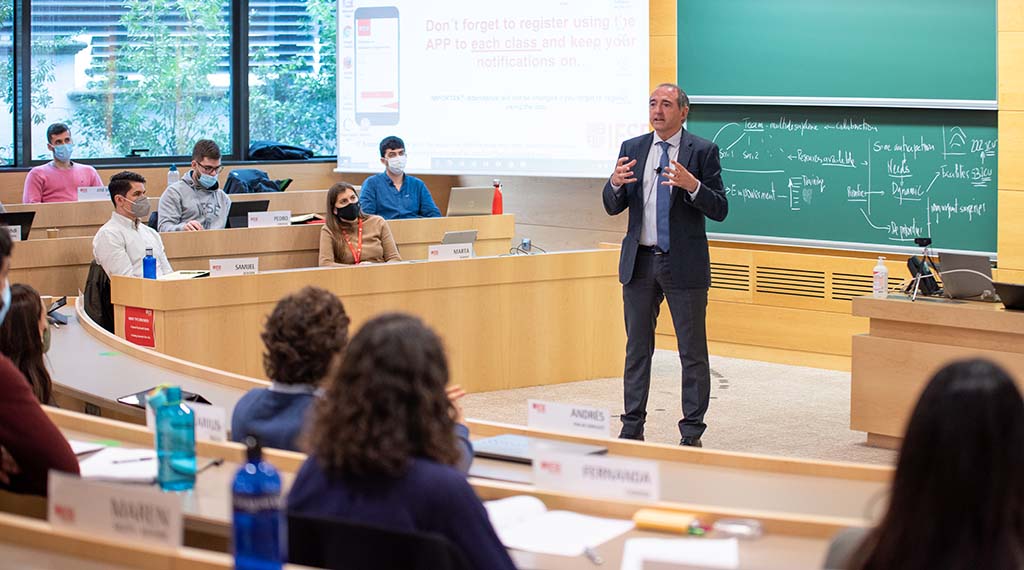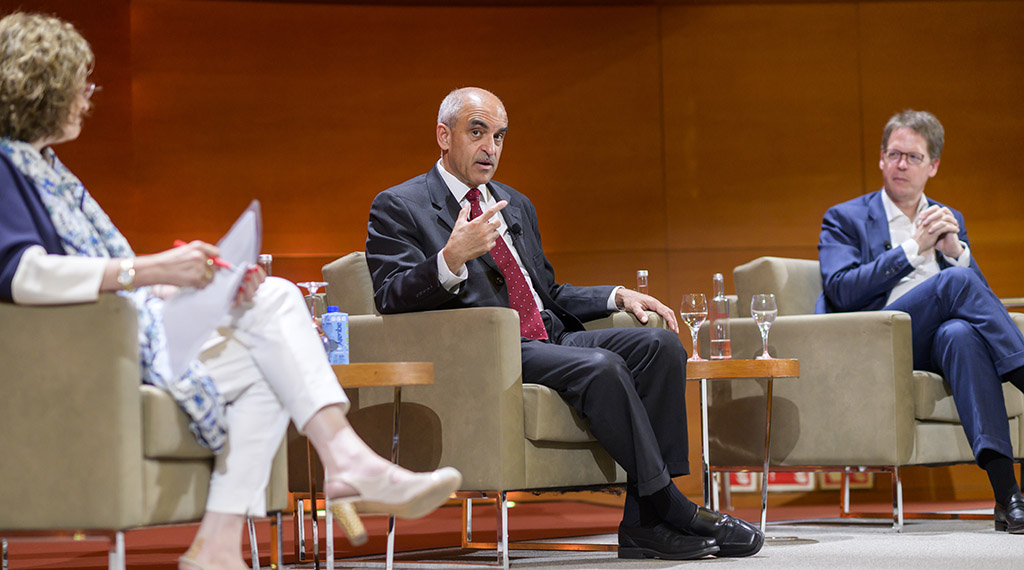Stories
New IESE case explores how one hospital managed COVID-19
MBA students discuss Barcelona-based Vall d’Hebron's management of first coronavirus wave
The managing director of Vall d’Hebron University Hospital, Albert Salazar, explained how the hospital transformed itself to manage the greatest health crisis the center has ever faced.
Photo: Edu Ferrer
February 22, 2021

Reflecting IESE’s commitment to immersing its students in the business world’s most relevant and timely issues, a case study exploring how Barcelona-based Vall d’Hebron University Hospital managed the first wave of the COVID-19 crisis was presented to an MBA class.
The case was presented by IESE professor and author of the case, Jaume Ribera, and the managing director of the Vall d’Hebron University Hospital, Albert Salazar, who explained how the hospital transformed itself during the first wave of the pandemic in order to manage the greatest health crisis the center has ever experienced.
Dr. Salazar presented the Vall d’Hebron management model and the main operational decisions that made it possible to face the first wave of the health crisis. Ribera, who is the academic director of IESE’s Center for Research in Healthcare Innovation Management, led discussion of the case, drawing out the learning points for other hospitals and business managers.
“Investigating how the pandemic was managed in a hospital like Vall d’Hebron is important, since up to now there has not been anything written about pandemic management in a hospital,” Ribera said. With this case study, “we have been able to see a real example of the evolution of the different phases of a crisis, and how it fits into the future strategy of a hospital center.”
A radical transformation
Management of the pandemic has been based on two axes, according to Dr. Salazar: “the need to work on any project in collaboration with all the region’s actors and, internally, to strengthen multidisciplinary teams. COVID-19 has shown us that breaking the traditional silos, sharing knowledge and working jointly across specialties, levels, doctors and nurses, can make it possible to achieve far superior results in terms of patient care.”
In Vall d’Hebron, the transformation started very early, even before there was a single case in Catalonia. The Hospital anticipated the arrival of the pandemic by drawing up protocols for action against COVID-19 and contingency plans that proposed up to a dozen scenarios in which, in the worst cases, ICU beds would triple and hospitalization would double.
At the end of January 2020, a Coordination Committee was also created made up of the Hospital’s management team and the leaders of the specialties most directly involved in the pandemic. In the committee meetings, which are still held, the evolution of the pandemic is analyzed and management decisions are taken based on the situation.
Likewise, an emergency public procurement model was designed in order to obtain the necessary PPE supplies, services and materials. Around 800 workers, including those in administration, doctors, pharmacists, etc. were sent home to continue their work remotely and thereby mitigate the risk of contagion. All outpatient visits were suspended and appointments were conducted online or by telephone. The home delivery of medications was also promoted. Family visits to patients were also suspended. As of today, non-COVID-19 patients are allowed visits in certain time slots, but COVID-19 patients are only allowed visits during the end-of-life process.
Future challenges and new collaboration with IESE
Coping with the pandemic is an ongoing challenge. During the first and second waves, Vall d’Hebron continued its transformation to face the challenge of different future scenarios. As part of this, on Feb. 16, 2021, the hospital inaugurated its new Garbí building, a multipurpose space dedicated to the care of patients with COVID-19 in Vall d’Hebron. The building has 56 acute beds and 32 critical and semi-critical beds and concentrates the care of patients with COVID-19.
IESE and Vall d’Hebron will also continue their collaboration to transmit the Hospital’s management model during this pandemic. In the near future, Dr. Salazar will offer other classes at IESE that delve into the key aspects of Vall d’Hebron management.
The Vall d’Hebron case, available at IESE Publishing, joins the more than 200 case studies written by IESE professors in the last three years, reflecting IESE´s aim of always being up-to-date in the analysis of business problems that arise in the classroom, which include cases of current topics in companies such as Netflix, Barça or Spotify, among many others.
Read more about the case method at IESE.







